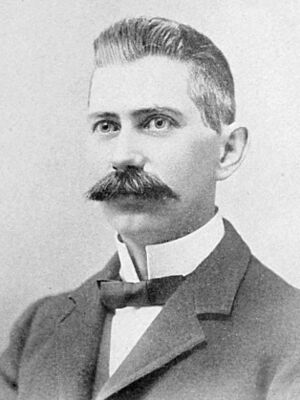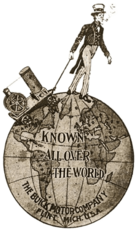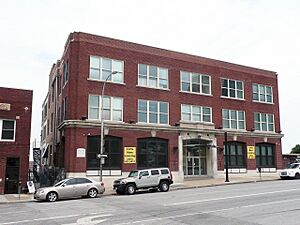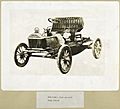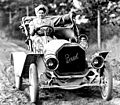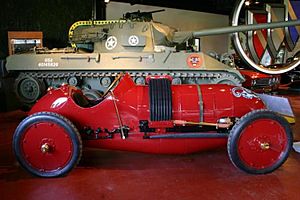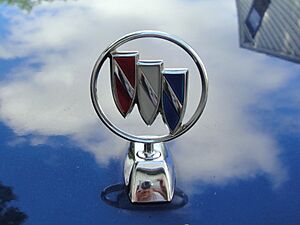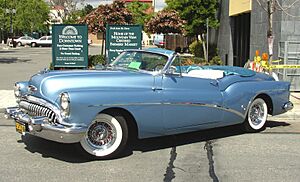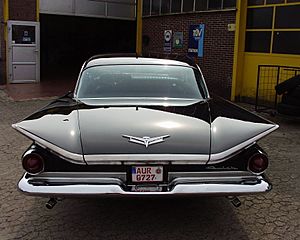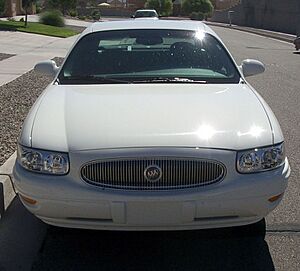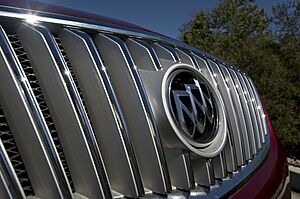Buick facts for kids
 |
|
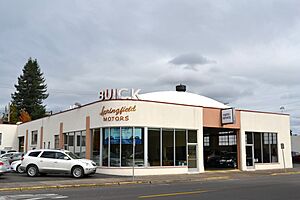
Buick dealership in Springfield, Oregon
|
|
|
Formerly
|
|
|---|---|
| Division | |
| Industry | Automotive |
| Founded | December 1899 |
| Founder | David Dunbar Buick |
| Headquarters |
Detroit, Michigan
,
U.S.
|
|
Area served
|
|
|
Key people
|
Jaclyn Mcquaid (vice president) |
| Brands | Electra (EV) |
| Parent | General Motors |
Buick is a well-known car brand from the United States. It's part of a bigger company called General Motors (GM). Buick was started by a person named David Dunbar Buick in 1899. It was one of the very first American car brands. In fact, Buick helped create General Motors in 1908! Today, Buick is the oldest American carmaker still around. Buick cars are known for being fancy and comfortable, a step below super luxury cars like Cadillac.
Contents
The Story of Buick
How Buick Started
Buick is one of the oldest car brands in the world. It's the oldest American car brand that still makes cars today. Other old carmakers like Autocar (started in 1897) now make big trucks. Oldsmobile (also from 1897) doesn't exist anymore.
The first two Buick cars were made in 1899 and 1900. A smart engineer named Walter Marr built them. But the company owner, David Dunbar Buick, wasn't sure about making cars. He liked making engines for boats and other machines. So, Walter Marr left in 1901.
Another engineer, Eugene Richard, took over. He got a patent for Marr's special "valve-in-head" engine design. This engine was very important for Buick. In 1904, Buick Motor Company moved to Flint, Michigan. Walter Marr came back to help build cars. That year, they made 37 cars. Production quickly grew to thousands of cars each year! By 1908, Buick was the biggest carmaker in the U.S.
David Buick officially started his company on May 19, 1903. A friend helped him with money. Later, a man named James H. Whiting took over. He wanted to put Buick's engines into his wagons. David Buick stayed on as a manager.
Whiting didn't make many cars at first. He ran out of money. So, he brought in William C. Durant as a main investor. Durant was a very successful businessman who made carriages. He helped Buick become the top-selling car brand in the U.S. David Buick sold his share of the company in 1906.
Between 1899 and 1902, two test cars were built. The first Buick cars for sale were the 1904 Model B. They had a special two-cylinder engine. Only 37 of these cars were made, and none exist today.
The early success of Buick was mostly thanks to its "valve-in-head" engine. This design was very good for its time. The success of Buick cars led to the creation of General Motors.
Billy Durant was a great promoter. Buick quickly became the biggest carmaker in America. Durant then started buying other car companies, and he called this new big company General Motors. He wanted each GM brand to sell cars to different types of buyers. Buick was placed just below the super luxury Cadillac brand.
Buick also got involved in car racing. They won the first race ever held at the Indianapolis Motor Speedway. In 1907, Buick introduced its first larger car, the Buick Model D, with a four-cylinder engine.
The 1910s and 1920s
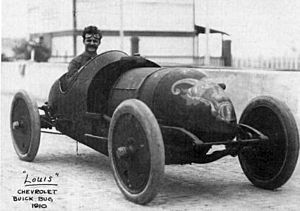
In 1910, Buick introduced the Model 10 with its special four-cylinder engine. In 1911, they made their first car with a closed roof, the Buick Six. This was four years before Ford made a similar car. During the 1920s, Buick made many different sizes of cars.
Buick cars were very popular in China during the 1910s and 1920s. Important people like the Emperor and high-level politicians used them. In 1924, the Emperor imported two Buick cars, which were the first cars to enter China. By 1930, Buick cars made up one-sixth of all cars in China. Today, Buick still sells most of its cars in China.
In 1929, Buick launched a sister brand called Marquette. This brand was meant to fill the price gap between Buick and Oldsmobile. But Marquette was stopped in 1930.
The 1930s
In 1931, Buick introduced two big improvements: the OHV Buick Straight-8 engine and a special synchromesh transmission that made shifting gears smoother. The Straight-8 engine came in different sizes. Buick also added turn signals to its cars in 1939, which was a first! Other car brands didn't have them for almost ten more years.
British royalty, like King Edward VIII and King George VI, bought McLaughlin-Buicks (Canadian-built Buicks) in the 1930s for their travels in Canada.
- Buick in the early years
-
1932 Buick Series 60 Model 67 sedan
After World War II
- 1940s–1950s
-
1956 Buick Century Riviera
The 1940s
In 1940, Buick started using the "Estate" name for its station wagons. Car production stopped in 1942 because of World War II. During the war, Buick made military vehicles like the M18 Hellcat tank destroyer and engines for airplanes. Car production started again in late 1945. In 1948, Buick offered its first automatic transmission, called Dynaflow. In 1949, Buick introduced its famous "VentiPorts" on the side of the cars.
The 1950s
1953 was Buick's 50th birthday! They also introduced the Buick V8 engine and the fancy Roadmaster Skylark. In 1955, Buick sold more cars than ever before, a record that lasted until 1977. In 1959, three new models were introduced: Electra, Invicta, and LeSabre. An Electra car also led the famous Indianapolis 500 race that year.
- 1960s–1970s
-
1973 Buick Century GS
-
1979 Buick Regal
The 1960s
Buick cars led the Daytona 500 race in 1960 and 1963. In 1961, a new Fireball V6 engine was introduced. The Skylark name returned as a top model. The Buick Special was named "Car of the Year" in 1962 by Motor Trend magazine. Also in 1962, the Wildcat model was introduced. In 1963, the very popular Riviera model was launched. In the mid-1960s, Buick started selling German-built Opel cars in North America.
The 1970s
The 1970s brought many new models to Buick, like the Estate Wagon, Centurion, Apollo, and Skyhawk. In 1975, the "Park Avenue" name first appeared as a special package on the Electra. A Buick Century car led the Indianapolis 500 race twice in the mid-1970s. In 1977, Buick redesigned its Electra and LeSabre models, making them smaller. Buick sold a record number of cars that year. In 1978, Buick celebrated its 75th birthday. The Buick Regal was redesigned and offered with a special turbocharged V6 engine. Buick broke another sales record in 1978. In 1979, the Riviera was redesigned and won "Car of the Year" from Motor Trend.
- 1980s–1990s
-
1994 Buick Century Estate
The 1980s
In the 1980s, many Buick models became smaller. In 1980, Lloyd Reuss became the general manager and pushed Buick to make more powerful, performance-focused cars. Also in 1980, a diesel engine became available on some Buick models. In 1981, the T-Type performance trim was introduced on the Riviera. The Regal was the official pace car for the Indianapolis 500 race in 1981.
In 1982, the high-performance Grand National package was first offered on the Regal. A special Riviera convertible helped bring back convertibles, which had almost disappeared from American car lineups. In 1983, Buick sold a record 810,435 vehicles.
In 1984, Buick was the official car of the XXIII Olympiad. Buick also opened a new, very modern factory called "Buick City" in Flint. Buick sold over 900,000 cars that year, and worldwide sales topped one million for the first time.
For 1985, Buick introduced a smaller Electra model. It was one of GM's first large cars with front-wheel drive. Buick also introduced the Somerset as its own model. Buick engines were very successful in racing, setting many records. 1985 was another record sales year for Buick, with over 915,000 vehicles sold.
In 1986, the LeSabre was redesigned with front-wheel drive. The Riviera was also made smaller and featured a high-tech electronic dashboard. In 1987, the last of the super-fast Regal Grand Nationals were made.
In 1988, Buick was the official car of the U.S. Olympic Team. The Reatta, a two-seater car, was introduced. The Regal was also made smaller and switched to front-wheel drive. Bobby Allison won the Daytona 500 race in a Regal that year. Buick's slogan became "The Great American Road Belongs to Buick."
In 1989, a new fancy Electra trim level called the Park Avenue Ultra was offered. The Riviera was also restyled and made longer. Buick cars were ranked very high in quality studies, leading to a new slogan: "Buick: The New Symbol for Quality in America."
The 1990s
In 1990, the first Reatta convertible was made. 1990 was also the last year for the Electra model. The Park Avenue, which used to be a trim level, became its own model in 1991. In 1991, Buick's sales and market share improved a lot. A new four-door Regal sedan was introduced. Buick also started offering a supercharged V6 engine in the Park Avenue Ultra. Supercharging became very popular for Buick.
In 1991, the Roadmaster car returned after 33 years. It was first offered as a wagon, and then a sedan was added in 1992. For 1992, the popular LeSabre was redesigned. A new Skylark was also introduced. In 1993, a special edition LeSabre was sold to celebrate Buick's 90th anniversary.
In 1995, the Riviera returned with a bold new look. It came with a powerful V6 engine, and a supercharged version was also available. In 1996, both the Roadmaster sedan and wagon were stopped. In 1998, Buick's main office moved to Detroit.
In 1999, the last of nearly 16 million Buicks were built at the "Buick City" factory in Flint. The last car, a 1999 LeSabre, was made on June 29. Buick was ranked very high in quality studies. With fewer people buying coupes, GM decided to stop making the Riviera. The last Riviera was made in November 1998.
Recent Years
- 2000s–2010s
-
2002 Buick Rendezvous
-
2008 Buick Enclave CXL
-
2011 Buick Regal GS
-
2016 Buick Cascada Premium
The 2000s
In the 2000s, Buick stopped making small cars and performance cars. Instead, they focused on crossover and SUVs, which were becoming very popular. In 2000, Buick introduced a redesigned LeSabre and a more powerful Century. Since the first Buick car in 1899, over 35 million Buicks had been built.
In 2001, Buick entered the crossover market with the Rendezvous. In 2003, Buick celebrated its 100th anniversary with a special concept car called the Buick Centieme. Some of its design ideas were later used in the 2008 Enclave crossover. In 2004, Buick added the Rainier SUV, and the Terraza minivan was added in 2005.
Over the next few years, Buick reduced its North American lineup to just three models: the LaCrosse, the Lucerne, and the new Enclave. There were rumors that Buick might be stopped, but its success in China kept the brand going. Instead, the Pontiac brand was stopped.
Since 2005, GM slowly combined Buick dealerships with GMC and former Pontiac dealerships. In 2009, Buick was named a "core brand" by General Motors. Buick also tied with Jaguar as the most dependable car brand in the U.S. in a study.
The 2010s
The 2010s saw the return of a classic Buick name, the Buick Regal, and several new models. Buick also introduced its first hatchback since 1987, its first factory convertible since 1991, and its first station wagon since 1996. Buick continued to grow in the popular crossover/SUV market.
In 2009, Buick showed off the new 2010 LaCrosse sedan, which had a fresh new look. People liked the LaCrosse, and it was compared to luxury cars like the Lexus ES. In 2010, Buick became the fastest-growing car brand in America and attracted younger buyers. Buick was positioned as a "premium" brand, competing with brands like Acura and Lexus.
A new Regal sedan, based on a European car, was brought back for the 2011 model year. For 2012, the new Verano, a compact sedan, joined the lineup. The performance-focused Regal GS also went on sale, becoming the first Buick in almost 20 years to offer a manual transmission and a turbocharger. Buick also entered the hybrid market with "eAssist" technology, which helped improve fuel economy.
In 2012, the new Encore mini crossover was shown. A turbocharged version of the Verano was introduced, and the Enclave was redesigned for 2013. In 2013, GM confirmed plans for Buick to share more designs with Opel/Vauxhall. The LaCrosse and Regal were updated for 2014.
In 2015, the new Cascada convertible debuted. The new 2017 LaCrosse was shown in late 2015. Buick also confirmed that the Envision compact crossover would be sold in North America starting in summer 2016. The Verano compact sedan was stopped in North America in 2017.
For 2018, Buick replaced the Regal sedan with a new model that offered hatchback and station wagon styles. This was the first Buick hatchback since 1987 and the first station wagon since 1996. Buick also added a fancy "Avenir" trim level for its top models. 2019 was the last year for the Cascada convertible and the LaCrosse sedan in North America.
The 2020s
New for 2020 was the Encore GX crossover, which fit between the existing Encore and Envision. The Regal hatchback and station wagon were stopped in North America in 2020.
In June 2022, Buick announced that all its cars would become electric vehicles by 2030. As part of this plan, Buick dealers had the option to take a buyout if they didn't want to switch to selling only electric cars. The Encore, once Buick's best-selling model in North America, was stopped in 2022. The larger Encore GX became Buick's new top seller. In 2023, the Envista was launched for the 2024 model year.
Buick's current lineup in North America includes the Envista and Encore GX small crossovers, the Envision compact crossover, and the Enclave mid-size crossover.
Buick Cars Today
Current Models
In China |
In North America
|
- Current lineup
Past Models
- Model B (1904)
- Model C (1905)
- Model D (1907–1908)
- Model F & G (1906–1910)
- Model K (1907–1908)
- Model 10 (1908–1910)
- Model S (1907–1908)
- Model 5 (1908)
- Model 14 & 14B (1910–1911)
- Model 16 (1909-1910)
- Model 17 (1909-1910)
- Model 19 (1910)
- Model 28, 29, 34, 36 & 43 (1912)
- Model 24, 25, 30, 31 & 40 (1913)
- Series B (1914)
- Series C (1915)
- Series D (1916–1917)
- Series E (1918)
- Series H (1919)
- Series K (1920)
- Series 21 (1921)
- Series 22 (1922)
- Series 23 (1923)
- Series 24 (1924)
- Master Series (1925–1928)
- Standard Series (1925–1928)
- Series 116, 121 & 129 (1929)
- Series 40 (1930–1935)
- Series 50 (1930–1935)
- Series 60 (1930–1935)
- Special (1936–1958, 1961–1969)
- Roadmaster (1936–1958, 1991–1996)
- Century (1936–1942, 1954–1958, 1973–2005)
- Super (1939–1958)
- Skylark (1953–1954, 1961–1972, 1975–1998)
- Invicta (1959–1963)
- Electra (1959–1990)
- LeSabre (1959–2005)
- Wildcat (1963–1970)
- Riviera (1963–1993, 1995–1999)
- Estate (1970–1979, 1990)
- Centurion (1971–1973)
- Apollo (1973–1975)
- Skyhawk (1975–1980, 1982–1989)
- Opel (1976–1979)
- Somerset (1985–1987)
- Reatta (1988–1991)
- Park Avenue (1991–2005, 2007–2012)
- Sail (2001–2004)
- Rendezvous (2001–2007)
- Excelle (2003–2023)
- Rainier (2004–2007)
- Royaum (2005–2006)
- Terraza (2005–2007)
- Lucerne (2006–2011)
- Excelle GT (2010–2023)
- Excelle XT (2010–2015)
- Encore (2013–2022)
- Cascada (2016–2019)
- Velite 5 (2017–2019)
- GL6 (2017–2023)
- Velite 7 (2020–2022)
- Electra E4 (2023–2025)
Concept Cars
- Concept cars
Buick has a long history of creating cool concept cars. These are special cars made to show new ideas and designs. The first one was the Y-Job in 1938. More recent concept cars from Buick are all electric vehicles. These include the Buick Enspire (2018), the Buick Electra (2020), and the Buick Wildcat (2022).
Special Buick Features
The Trishield Logo
The Buick Trishield is the brand's famous logo. It comes from the family crest of David Dunbar Buick, the founder. This crest had a red shield with a checkered line, a deer, and a cross. Buick started using this shield on its car grilles in 1937.
In 1960, the logo changed a lot. It became three shields in red, white, and blue. These three shields represented the three main Buick models at the time: the LeSabre, Invicta, and Electra. The logo changed again over the years, becoming simpler. In 2005, it became one color, but the traditional red, white, and blue returned in 2023.
VentiPorts
A classic Buick design feature since 1949 is a set of three or four vents on the front fender, just behind the front wheels. These were called VentiPorts. At first, they were meant to help air flow out of the engine. But soon, they became just a cool styling detail.
When they first appeared, the number of VentiPorts (three or four) showed the size of the engine. Later, the number of VentiPorts showed the size of the car. In 1961, when Buick introduced its first V6 engine, the VentiPorts started to show the number of cylinders in the engine. V6 models had three vents, and V8 models had four. VentiPorts were used on some Buick models until 1981. They were brought back in 2003 on the Buick Park Avenue Ultra and later on the Lucerne.
The Sweepspear Design
Another special design feature from the 1940s to the 1970s was the Sweepspear. This was a curved line of trim that ran almost the entire length of the car. It started as an option in 1949 and became a standard feature on all Buicks by 1951. On cars with two-tone paint, the Sweepspear often separated the two colors.
The Sweepspear changed over the years. It was originally made of shiny stainless steel. Later, it became a vinyl strip or just a sculpted line in the car's body.
Delta Fin
In 1958, Buick cars got a new look. The Sweepspear design changed into a "Delta Fin," which looked like a rocket ship. This was because the "space age" had just begun. These fins were made smaller in 1960 and removed in 1961.
Taillight Shapes
During the 1950s, Buick's taillights often looked like small, round bullets stacked together. In the early 1960s, most models started using wide, rectangular taillights. Then, in 1965, some models had taillights that went all the way across the back of the car.
Classic Grille Style
A Buick design that has appeared many times is the grille. It's usually a horizontal oval with many thin, vertical chrome bars that stick out a bit. People sometimes called this the Buick "dollar grin," especially on cars from the early 1950s.
Waterfall Grille
In recent years, Buick has used a waterfall grille. This grille looks like a waterfall and was first seen on a concept car in 2004. It was first used on a production car with the Buick Lucerne in 2006. This waterfall grille looks a bit like grilles from Buicks in the 1980s.
Nailhead Engine
The Buick V8 engine was nicknamed the Nailhead. This was because its intake and exhaust valves were relatively small and looked like nails. This engine became popular with people who liked to customize cars in the 1950s and 1960s. Its design allowed it to fit into smaller spaces easily.
Performance Cars
Besides making fancy and comfortable cars, Buick has also been known for building high-performance cars. Some famous examples include the Gran Sport and Skylark GSX models from the 1960s and 1970s. In the 1980s, the Grand National and GNX models were very powerful. Buick also offered a performance package called T-Type.
Where Buicks Are Sold
Asia
Buick is one of the most popular and best-selling car brands in China. In 2016, General Motors sold over 1.1 million Buicks there. Buicks have always been popular in China. Before World War II, one out of every five cars in China was a Buick. Important leaders like the last emperor and the first president used Buicks.
Since 1999, a special Buick Regal for China has been made and sold by Shanghai GM. It's very popular with professional families. Buick of China also sells a small Excelle hatchback and a minivan called the GL8. Many Buicks for the Chinese market have smaller, more fuel-efficient engines.
In Taiwan, Buick cars were very popular in the early 1990s. Models like the Park Avenue and Regal were sold there. In 2005, General Motors started a joint company with a Taiwanese firm to make Buick cars there.
In April 2010, Buick introduced a special version of the LaCrosse called Alpheon for the South Korean market.
Mexico
Buicks were sold in Mexico from 1921 until 1962. Then, a government rule limited how many imported parts could be used in cars. All GM cars were sold through Chevrolet dealerships. In 1990, GM started making the Buick Century in Mexico. People sometimes called it the "Chevrolet Century."
In 1997, GM stopped selling Buicks in Mexico. The brand wasn't sold there again until 2009. In 2009, Buick returned to Mexico with the LaCrosse and Enclave models. Buick shared dealerships with Pontiac and GMC until Pontiac was stopped in 2010.
In 2019, Buick announced that its Mexican division would only sell crossovers (Encore, Envision, and Enclave). The LaCrosse sedan and Regal models were stopped in Mexico.
Middle East
In Israel, Buick cars are imported by Universal Motors, Ltd. Buicks were sold throughout the Middle East until 1996.
New Zealand
Buicks were once sold in New Zealand. They were also built at the GMNZ plant in Petone.
Car Racing
For many years, Buick cars were used in car racing. Driver Phil Shafer won the 1933 Elgin Trophy race in a Buick. This was one of the first organized stock car races in the U.S.
Buick also competed in the Indianapolis 500 race and the Grand National stock car racing series. They used models like the Regal and Gran Sport.
The 1980s were a great time for Buick in racing. General Motors entered the Regal, especially the Grand National model, in NASCAR Cup Series races. Buick was also a major engine supplier in the IndyCar Series. However, the 1990s marked the end of Buick's big role in motorsports.
Fan Clubs
The Buick Club of America was started in 1966. It's a group dedicated to keeping old Buick cars in good condition and restoring them.
Images for kids
See also
 In Spanish: Buick para niños
In Spanish: Buick para niños
- List of automobile manufacturers of the United States


